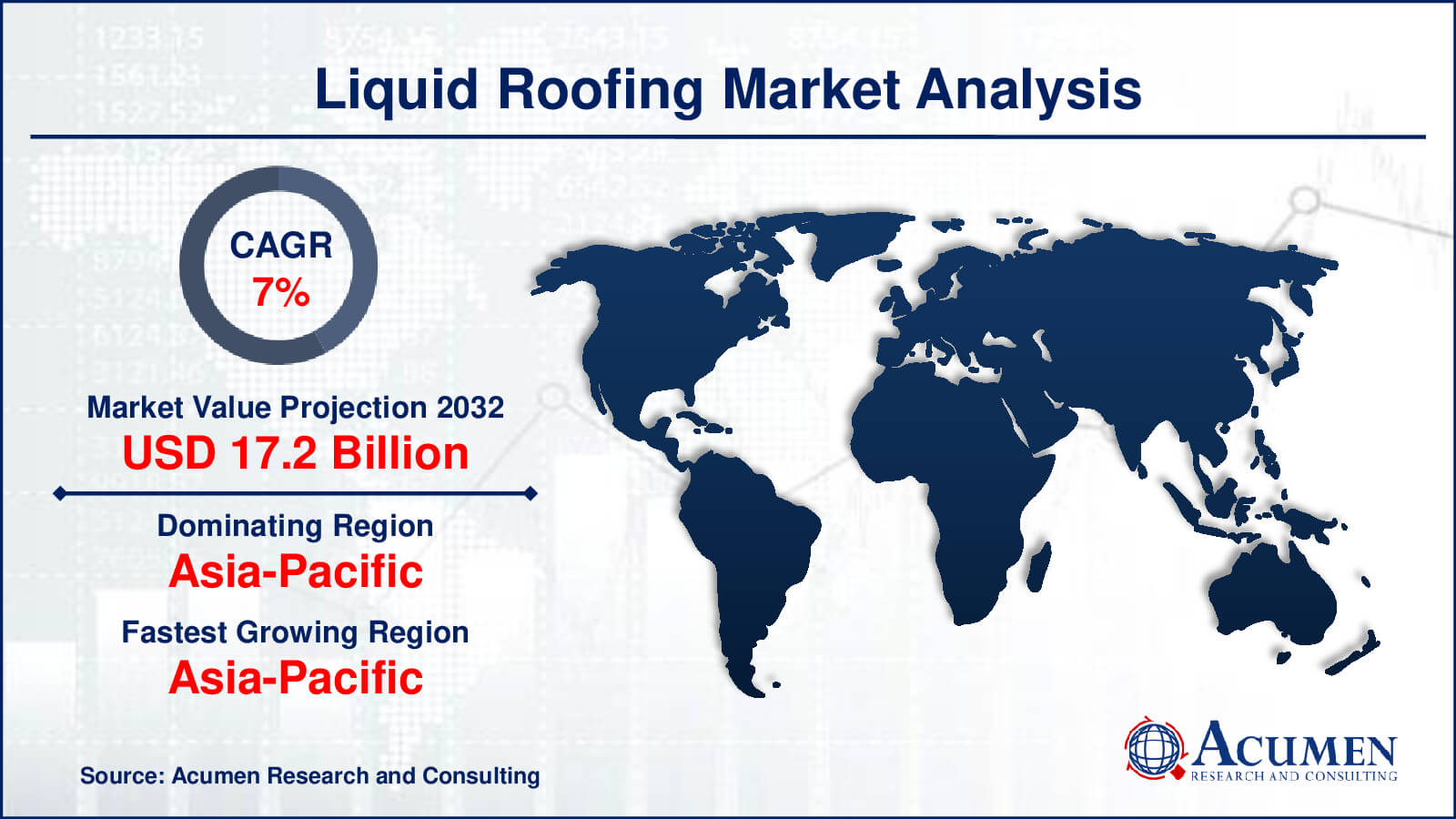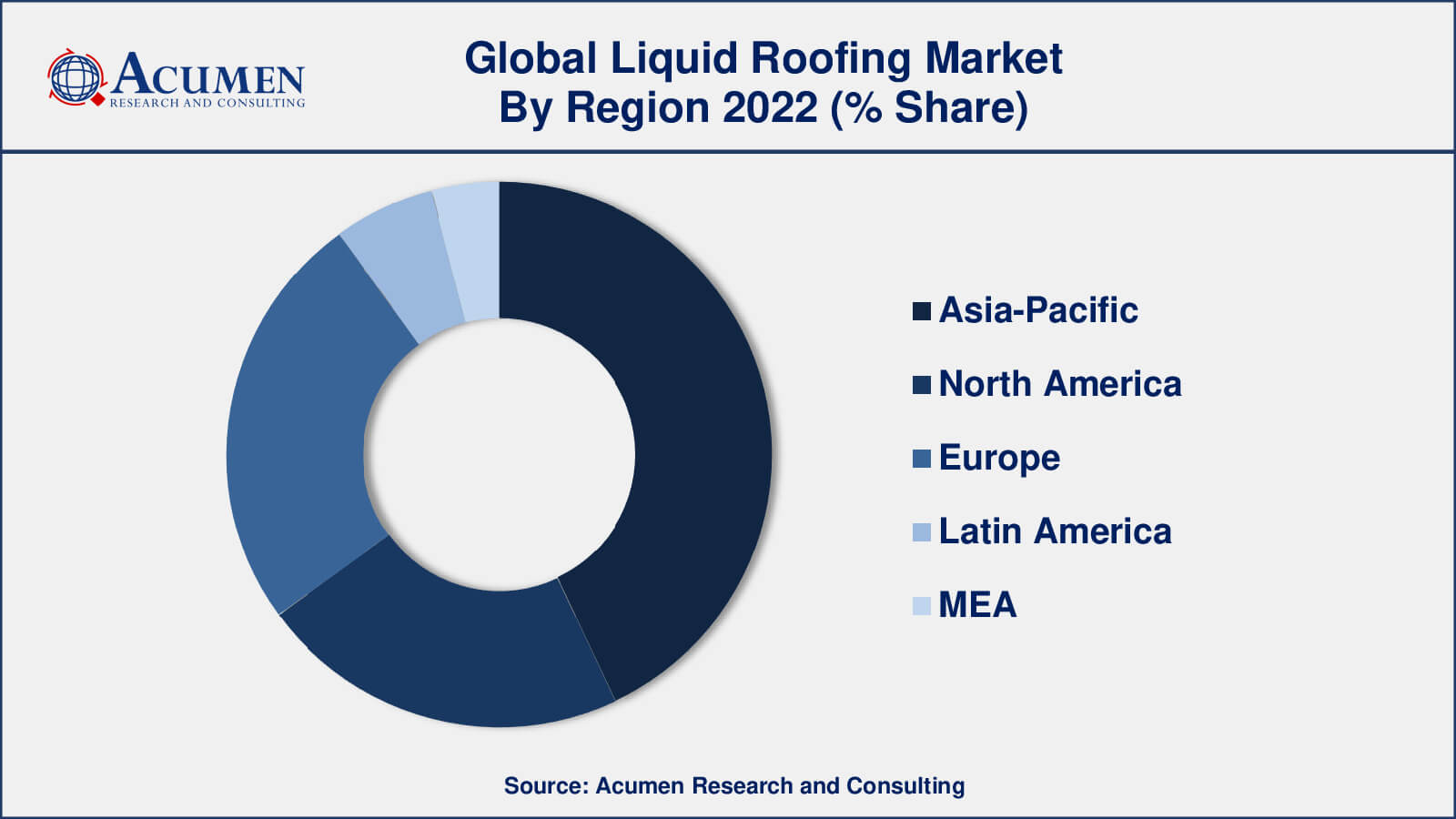Liquid Roofing Market | Acumen Research and Consulting
Liquid Roofing Market Size - Global Industry, Share, Analysis, Trends and Forecast 2023 - 2032
Published :
Report ID:
Pages :
Format :
The Global Liquid Roofing Market Size accounted for USD 8.3 Billion in 2022 and is projected to achieve a market size of USD 17.2 Billion by 2032 growing at a CAGR of 7% from 2023 to 2032.
Liquid Roofing Market Report Key Highlights
- Global liquid roofing market revenue is expected to increase by USD 17.2 Billion by 2032, with a 7% CAGR from 2023 to 2032
- Asia-Pacific region led with more than 38% of liquid roofing market share in 2022
- According to studies, liquid roofing is extremely durable and can endure for up to 25 years or more if properly maintained
- In 2019, liquid-applied roofing systems accounted for around 10% of the total low-slope roofing market in the United States
- Silicone and acrylic coatings are the most popular types of liquid-applied roofing systems utilized in the United States
- Increasing demand for high-quality, long-lasting, and sustainable infrastructure, drives the liquid roofing market size

Liquid roofing is a type of roofing system that is applied in a liquid form and then hardens into a seamless, waterproof membrane. It is commonly used in commercial and industrial applications, but can also be used in residential settings. The liquid roofing system can be applied to a variety of surfaces, including metal, concrete, asphalt, and single-ply roofing systems. The material is typically made from a combination of resins, polymers, and fillers that provide excellent resistance to weathering, UV radiation, and chemical exposure.
The liquid roofing market has experienced significant growth in recent years due to the many benefits it offers. Liquid roofing systems are cost-effective compared to traditional roofing systems, especially in terms of installation and maintenance costs. They are also highly durable, resistant to extreme weather conditions, and can provide energy savings due to their reflective properties. Additionally, liquid roofing systems are environmentally friendly, as they can be installed over existing roofs, reducing the need for costly and time-consuming tear-offs. The market growth of liquid roofing is expected to continue in the coming years, driven by increasing demand from commercial and industrial applications. The rise in construction activities, particularly in emerging economies, is expected to contribute significantly to the growth of the liquid roofing market value.

Global Liquid Roofing Market Trends
Market Drivers
- Cost-effectiveness compared to traditional roofing systems
- High durability and resistance to extreme weather conditions
- Energy savings due to reflective properties
- Environmentally friendly and can be installed over existing roofs
- Increasing demand from commercial and industrial applications
Market Restraints
- Lack of skilled labor for installation
- Limited availability of raw materials
Market Opportunities
- Developing new technologies and materials for liquid roofing
- Increasing use of liquid roofing in residential applications
Liquid Roofing Market Report Coverage
| Market | Liquid Roofing Market |
| Liquid Roofing Market Size 2022 | USD 8.3 Billion |
| Liquid Roofing Market Forecast 2032 | USD 17.2 Billion |
| Liquid Roofing Market CAGR During 2023 - 2032 | 7% |
| Liquid Roofing Market Analysis Period | 2020 - 2032 |
| Liquid Roofing Market Base Year | 2022 |
| Liquid Roofing Market Forecast Data | 2023 - 2032 |
| Segments Covered | By Type, By Application, And By Geography |
| Regional Scope | North America, Europe, Asia Pacific, Latin America, and Middle East & Africa |
| Key Companies Profiled | BASF SE, Sika AG, GAF Materials Corporation, The Dow Chemical Company, Johns Manville Corporation, Saint-Gobain S.A., Kemper System America, Inc., Carlisle Companies Inc., Mule-Hide Products Co., Inc., and Henry Company LLC. |
| Report Coverage |
Market Trends, Drivers, Restraints, Competitive Analysis, Player Profiling, Covid-19 Analysis, Regulation Analysis |
The process of applying liquid coatings on a roof surface for the purpose of waterproofing is known as liquid roofing. Liquid roofing can be done on any surface, for instance flat, domed, or pitched. The coating is applied on the roof surface to protect it from weather conditions. Glass-reinforced plastic is the main component used for liquid roofing. Asphalt, concrete, bitumen, and felt are the other materials used in the liquid roofing process. Liquid roofing ensures the protection of the roof surface for as long as 25 years.
The global liquid roofing market is growing at a significant pace owing to the growth in construction activities around the world. Moreover, the need for energy-efficient buildings also paves the way for the liquid roofing market growth. The liquid roofing process is also cost-efficient for the users as well as suppliers, hence supporting the market for liquid roofing. However, the fluctuating raw material prices used in the liquid roofing process hinder market growth. The high cost of some raw materials used in liquid roofing such as elastomeric membrane restricts the market growth. The major growth opportunity for manufacturers of liquid roofing lies in emerging economies such as India, China, Brazil, Argentina, UAE, Saudi Arabia, and parts of Africa, where government policies support infrastructure growth.
Liquid Roofing Market Segmentation
The global liquid roofing market segmentation is based on type, application, and geography.
Liquid Roofing Market By Type
- Polyurethane Coatings
- Epoxy Coatings
- Acrylic Coatings
- Silicone Coatings
- Bituminous Coatings
- Others
According to a liquid roofing industry analysis, the acrylic coatings segment accounted for a significant share of the market, and its demand is expected to continue to grow in the coming years. Acrylic coatings are made from acrylic polymers and can be used on a variety of surfaces, including concrete, metal, and asphalt. They are often used as a topcoat over existing roofs, providing a seamless and durable waterproof barrier. One of the main advantages of acrylic coatings is their high reflectivity, which can help to reduce energy costs by keeping buildings cooler in hot weather. They also provide excellent resistance to UV radiation, which helps to prevent degradation and extend the lifespan of the roof. Additionally, acrylic coatings are easy to apply, require minimal maintenance, and are available in a range of colors and finishes. The demand for acrylic coatings in the liquid roofing market is expected to continue growing, driven by increasing demand for energy-efficient and sustainable building solutions.
Liquid Roofing Market By Application
- Residential
- Industrial/Institutional
- Commercial
- Infrastructure
According to the liquid roofing market forecast, the residential segment is expected to have significant growth in the coming years. The residential segment is an important part of the liquid roofing market, as homeowners and building owners look for durable and cost-effective roofing solutions that can protect their property from the elements. Liquid roofing systems offer several advantages over traditional roofing materials, including ease of installation, durability, and energy efficiency. In recent years, the use of liquid roofing systems in residential applications has been increasing, as more homeowners become aware of the benefits of these systems. The demand for liquid roofing systems in the residential segment is expected to continue growing, driven by increasing demand for sustainable and energy-efficient building solutions.
Liquid Roofing Market Regional Outlook
North America
- U.S.
- Canada
Europe
- U.K.
- Germany
- France
- Spain
- Rest of Europe
Asia-Pacific
- India
- Japan
- China
- Australia
- South Korea
- Rest of Asia-Pacific
Latin America
- Brazil
- Mexico
- Rest of Latin America
The Middle East & Africa
- South Africa
- GCC Countries
- Rest of the Middle East & Africa (ME&A)

Liquid Roofing Market Regional Analysis
Asia-Pacific dominates the liquid roofing market due to several factors, including rapid urbanization, industrialization, and infrastructure development in the region. The growth in construction activities has resulted in an increasing demand for durable and cost-effective roofing solutions, and liquid roofing systems have emerged as a popular choice among builders and contractors in the region. The Asia-Pacific region is home to several rapidly developing economies, including China, India, and Indonesia, which have been investing heavily in infrastructure development. These countries are expected to drive demand for liquid roofing systems in the coming years, as they seek to build new residential, commercial, and industrial buildings that require high-quality roofing solutions.
Liquid Roofing Market Player
Some of the top liquid roofing market companies offered in the professional report includes BASF SE, Sika AG, GAF Materials Corporation, The Dow Chemical Company, Johns Manville Corporation, Saint-Gobain S.A., Kemper System America, Inc., Carlisle Companies Inc., Mule-Hide Products Co., Inc., and Henry Company LLC.
Frequently Asked Questions
What was the market size of the global liquid roofing in 2022?
The market size of liquid roofing was USD 8.3 Billion in 2022.
What is the CAGR of the global liquid roofing market during forecast period of 2023 to 2032?
The CAGR of liquid roofing market is 7% during the analysis period of 2023 to 2032.
Which are the key players operating in the market?
The key players operating in the global liquid roofing market are BASF SE, Sika AG, GAF Materials Corporation, The Dow Chemical Company, Johns Manville Corporation, Saint-Gobain S.A., Kemper System America, Inc., Carlisle Companies Inc., Mule-Hide Products Co., Inc., and Henry Company LLC.
Which region held the dominating position in the global liquid roofing market?
Asia-Pacific held the dominating position in liquid roofing market during the analysis period of 2023 to 2032.
Which region registered the fastest growing CAGR for the forecast period of 2023 to 2032?
Asia-Pacific region exhibited fastest growing CAGR for liquid roofing market during the analysis period of 2023 to 2032.
What are the current trends and dynamics in the global liquid roofing market?
The current trends and dynamics in the liquid roofing industry include the increasing demand from commercial and industrial applications, and rise in construction activities.
Which application held the maximum share in 2022?
The residential application held the maximum share of the liquid roofing market.



